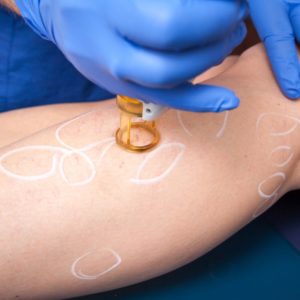
Sclerotherapy
Many people hear about sclerotherapy right away when they start seeking information about vein treatments. Sclerotherapy was one of the first nonsurgical vein treatments to be developed many years ago. Because it has been around for so long, we know without a doubt that it works well. This injection technique works by inserting a mild irritant called a sclerosing agent into a vein. The agent causes the inner walls of the vein to swell and stick together. The vein collapses, and blood circulates elsewhere. Sclerotherapy is minimally invasive and only mildly uncomfortable. Patients feel a tiny pinch from the fine needle and may experience mild cramping due to controlled inflammation in the vein. This side effect usually does not last long.
Endovenous Laser Therapy
Like sclerotherapy, the purpose of endovenous laser therapy, or venous ablation, is to close down the nonfunctioning vein. Treatment is performed through a tiny nick in the skin, through which the provider inserts a thin laser fiber. Ultrasound imaging guides the fiber through the vein to the spot of closure. The device then pulses laser energy into the vein as the provider slowly removes it. Energy deposited along the length of the vein causes collapse, resulting in circulation finding an alternate route.
Compression Stockings
Patients who undergo vein therapy of any kind will likely wear medical grade compression stockings both before and after treatment. Medical insurance often requires pre-treatment compression for several weeks as a criterion for coverage. After treatment, compression helps reduce swelling and bruising and it also helps close the vein quickly and efficiently. Medical grade compression garments comfortably press on the legs, which relieves some of the stress of moving blood back toward the heart. Some people continue to rely on compression garments for many years after vein treatment as a way to manage chronic venous insufficiency.
Vein treatments have evolved with new technologies to become less invasive without losing efficiency. To learn more about our available vein treatments, contact us at (301) 374-8540 for an appointment.

